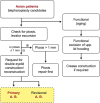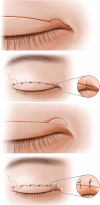Techniques, Principles and Benchmarks in Asian Blepharoplasty
- PMID: 31333982
- PMCID: PMC6571304
- DOI: 10.1097/GOX.0000000000002271
Techniques, Principles and Benchmarks in Asian Blepharoplasty
Abstract
Background: Asian blepharoplasty is a deceptively simple procedure where the goal is to create an upper lid crease. The author presents a retrospective self-analysis of 362 cases performed over the past 12 years.
Methods: 362 cases that fits the inclusion criteria were tabulated into spreadsheet data format. Recorded were age, gender, date of service and follow-ups, whether the AB performed was for primary or revisional purpose; the preoperative lid crease status, the patient-chosen crease height as well as shape preferred. Intraoperative observation included presence or absence of preaponeurotic fat, whether partially resected, or reposited were noted.
Results: Of 362 patients (724 upper lids), primary AB constituted 81% (295) and revisional AB contributed 19% (67). The gender distribution was 87% female (315) and 13% male (47). The age distribution ranged from 12 to 75 years. The crease height selected ranged from 6.0 to 8.0 mm, with the median being 7.0 mm. Of the crease shape chosen, parallel shape was 65% (236) and nasally-joining crease shape was 35% (126).
Conclusions: Asian blepharoplasty via trapezoidal debulking of preaponeurotic platform is a safe, effective and anatomically-based technique that does not involve the use of permanent buried sutures. The article discussed the 5 essential factors (aponeurotic attachment, selective block clearance of preaponeurotic space, precise positioning of the crease formation loci, detection of latent droopy eyelids and avoidance of Faden-like suture effect) and the author's benchmarks to achieve a better success rate. Results for primary and revisional Asian blepharoplasty, strategies and potential pitfalls are presented. ( http://links.lww.com/PRSGO/B141).
Figures














References
-
- Chen WP. Literature on double eyelid surgeries: appendix 1,2,3. In: Asian Blepharoplasty and the Eyelid Crease. 2016:3rd ed Edinburgh/New York: Elsevier; 345–365.
-
- Chen WP. Concept of triangular, trapezoidal, and rectangular debulking of eyelid tissues: application in Asian blepharoplasty. Plast Reconstr Surg. 1996;97:212–218. - PubMed
-
- Collin JR, Beard C, Wood I. Experimental and clinical data on the insertion of the levator palpebrae superioris muscle. Am J Ophthalmol. 1978;85:792–801. - PubMed
-
- Cheng J, Xu FZ. Anatomic microstructure of the upper eyelid in the oriental double eyelid. Plast Reconstr Surg. 2001;107:1665–1668. - PubMed
-
- Morikawa K, Yamamoto H, Uchinuma E, et al. Scanning electron microscopic study on double and single eyelids in Orientals. Aesthetic Plast Surg. 2001;25:20–24. - PubMed
LinkOut - more resources
Full Text Sources
Miscellaneous
